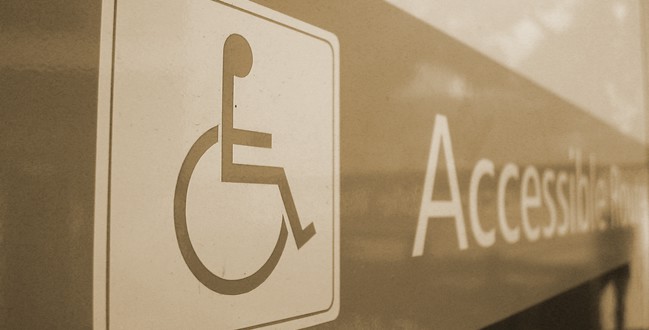
In various instances during my research I come across articles and recommendations that tend to confuse usability with accessibility. The objective of this post is to establish the link between the two terms while outlining their differences. In order to do so, it is important to first understand what is web site usability and web site accessibility.
What is Web Site Usability?
The term "usability” was created in the early 1980's to refer to what was then a number of vague and subjective attributes of a product, collectively known as "user friendly characteristics” [1]. This marked the beginning of an important shift from a phrase that focused on the features of the interface of a product to a term that was becoming concerned with the various facets of the interaction as seen from the human action perspective [2].
Various researchers ([3], [4], [5], [6]) have based their definition of usability on the International Standards Organization's standard ISO9241, which defines usability as the "effectiveness, efficiency and satisfaction with which specified users achieve specified goals in particular environments” [7].
A less formal definition is provided by Nielsen and Loranger [8], who define usability as an attribute of quality that refers to the promptness with which users learn to use something, the efficiency they attain while making use of it, how easy it is for them to remember how to use it, how error-prone it is and the level of satisfaction that they attain from using it.
From all the definitions listed above, it is clear that usability is concerned with effectiveness, efficiency and satisfaction. Brajnik [9] and Dix et al. [3] define effectiveness as the preciseness and completeness with which specific users can attain specific goals in a specific environment, efficiency as the resources that would be needed to achieve such preciseness and completeness and satisfaction as the level of comfort and acceptability of the system as viewed by its users and the people who it affects through its usage.
What is Web Site Accessibility?
The World Wide Web Consortium [10] defines web accessibility as an attribute through which "people with disabilities can perceive, understand, navigate, and interact with the web, and they can contribute to the web”. Web accessibility includes all types of disabilities that impact access to the web and thus includes visual, auditory, physical, speech, cognitive and neurological disabilities and adherence to web accessibility principles also benefits elderly users.
So as to improve web site accessibility, the World Wide Web Consortium (W3C) has set up the Web Accessibility Initiative (WAI) which publishes the Web Content Accessibility Guidelines (WCAG) - a set of guidelines with the aim of making the web content more accessible to people with disabilities and indirectly to users in general ([11], [12]).
What is the Relationship and Difference between the Two?
Based on the above definitions, and additional researched material, one can conclude the following:
- An accessible web site would benefit all users, not just those who are disabled [13]
- Accessibility is a subset of usability [9]
- A web site is not usable unless it is accessible [14]
- Whilst usability implies accessibility, the contrary is not necessarily true [9]
Referenced Work
- Bevan, N., Kirakowski, J. & Maissel, J., 1991. What is usability? In Proc. 4th International Conference on HCI. Stuttgart, Germany, 1991.
- Dillon, A., 2001. Beyond usability: process, outcome and affect in human computer interactions. In Paper presented at the Lazerow Lecture 2001, Faculty of Information Studies. Toronto, Canada, 2001.
- Dix, A., Finlay, J., Abowd, G.D. & Beale, R., 2004. Human Computer Interaction. 3rd ed. Essex, England: Pearson Education Ltd.
- Ivory, M.Y. & Hearst, M.A., 2001. The state of the art in automating usability evaluation of user interface. ACM Computing Surveys (CSUR), December. pp.470-516.
- Powell, T.A., 2002. Web design: the complete reference. 2nd ed. New York, United States: Academic Press.
- Otaiza, R., Rusu, C. & Roncagliolo, S., 2010. Evaluating the usability of transactional web sites. In Third International Conference on Advances in Computer-Human Interactions. Saint Maarten, Netherlands, Antilles, 2010.
- International Organisation for Standardisation, 1998. ISO9241 Ergonomic, Part 11: Guidance on usability. Geneva, Switzerland.
- Nielsen, J. & Loranger, H., 2006. Prioritizing web usability. Berkeley, CA, United States: New Riders Press.
- Brajnik, G., 2000. Automatic web usability evaluation: what needs to be done? In Proc. 6th Conference on Human Factors and the Web. Austin, Texas, United States, 2000.
- World Wide Web Consortium W3C, 2010b. Web Accessibility Initiative (WAI). [Online] Available at: http://www.w3.org/WAI/intro/accessibility.php
- World Wide Web Consortium W3C, 1999. Web Content Accessibility Guidelines - WCAG v.1.0. [Online] Available at: http://www.w3.org/TR/WCAG10/
- World Wide Web Consortium W3C, 2008. Web Content Accessibility Guidelines - WCAG v.2.0. [Online] Available at: http://www.w3.org/TR/WCAG20/
- Matera, M., Rizzo, F. & Toffetti Carughi, G., 2006. Web usability: principles and evaluation methods. In E. Mendes & N. Mosley, eds. Web Engineering. Berlin, Germany: Springer Berlin Heidelberg. pp.143-80.
- Krug, S., 2006. Don't make me think: a common sense approach to web usability. 2nd ed. Berkeley, California, United States: New Riders Press.

 Enterprise Software: How To Improve Usability
Enterprise Software: How To Improve Usability 6 Principles Of Visual Accessibility Design
6 Principles Of Visual Accessibility Design Hyperlink Usability: Guidelines For Usable Links
Hyperlink Usability: Guidelines For Usable Links Windows 10 vs macOS Sierra: Part 2 - Mobile Integration & Multitasking
Windows 10 vs macOS Sierra: Part 2 - Mobile Integration & Multitasking